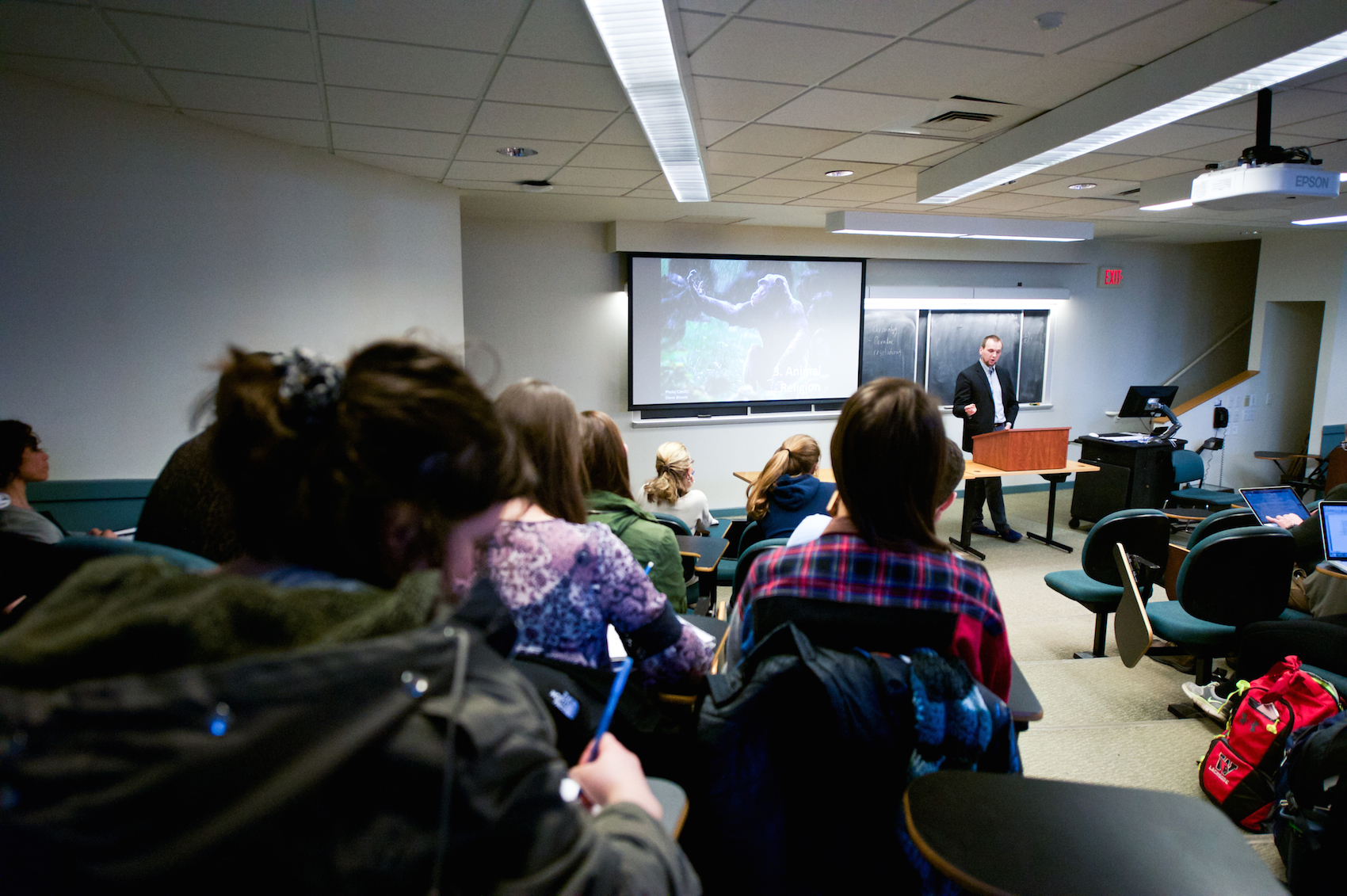
Lex Spirtes, Photo Editor
On Thursday, March 24, Wesleyan hosted University of Oxford Professor Donovan Schaefer, who gave a talk called “You Don’t Know What Pain Is: Affect, Religion, and Animal Ethics.”
He was introduced by Visiting Assistant Professor of Religion Jennifer Caplan.
“His talk today…uses the growing literature of affect theory to investigate the relationship between the worlds animals inhabit and our treatment of them, such as factory farming and containment,” Caplan said.
After thanking everyone who helped him in the process of coming to lecture at Wesleyan, he turned to what he called a very interesting contemporary thinker to begin to address the large and complicated issue of pain. Schaefer then read these lines from Kendrick Lamar’s “Don’t Kill My Vibe”: “I can say that I like a challenge and you to me is painless/ You don’t know what pain is/ How can I paint this picture/ When the color blind is hanging with ya,” coyly leaving out the first word of Lamar’s hit song off of his album Good Kid, M.A.A.D City.
“I really liked how Professor Schaefer related the more abstract concept of pain to a modern form of art,” Phuong Le ’18 said. “I think that allows further understanding by allowing a connection to a wider audience.”
Lamar’s moving lyrics hit on a topic important to Schaefer: the concept of invisible pain and the difficulty of sharing pain with others.
“This invisible pain isn’t just the pain of collisions or trauma, it’s the pain of deprivation,” Schaefer explained as he tapped his finger on the podium. “Lamar’s perspective is that telling a sad story is not the same as calling someone to share that pain.”
Schaefer went on to say that although many animal activists focus on the gruesome nature of the physical damage and murder that haunts the lives of animals, he wants to focus on the subtler—but possibly even more frightening—invisible pain.
Through his lecture, Schaefer suggested that the link humans often make between religion and language is flawed, instead proposing that religion is predominantly determined by affects. He views affects as forces that have a large part in shaping our worlds. They are more elusive than just pure happiness or sadness, but through this subtlety they create a potential model of religion that surpasses the linguistic. Through his transfer of religion to the affective realm, Schaefer breaks the anthropocentric link that exists between language and religion and opens the field up to non-human animals.
Schaefer presented one of Jane Goodall’s experiences as an example of this new definition of religion. Goodall, a British anthropologist, witnessed a chimpanzee ritual that occurs when they are confronted with a waterfall: They dance fervently with what seems to be wonderment at their surroundings.
“My argument is simply that chimps, like humans, are equipped with…biophilia, which is a set of predispositions to respond to elements of the natural world with intense emotion,” Schaefer said.
Just as rabbits leap and jump for what seems to be pure joy, these chimpanzees’ affective responses to the beauty that surrounds them is their own way of prayer. Even though animals present us with their versions of rituals and prayer, we disallow the idea that meaning can be produced without linguistic power. Our anthropocentric viewpoint disallows a version of religion that does not include linguistics.
“I really enjoyed the talk,” Nadja Shannon-Dabek ’17 said. “I appreciated how much Professor Schaefer challenged my ideas about the distinction between humans and animals, and particularly the ways that he deconstructed the notion of human exceptionalism.”
Schaefer moved to the next slide, a close-up photograph of a chimpanzee dancing in a spray of water. Schaefer said that solitary confinement is only a punishment for beings that are complex and vastly interconnected with their world. This invisible bond defies the notion that animals are solely automatons.
Animals use non-linguistic communication to connect with their worlds, and solitary confinement disallows that communication from which religions arise. Schaefer spoke about the enigmatic Harry Harlow to address this point. Harlow, an American psychologist, showed the true horrors of solitary confinement through his pit of despair. Harlow placed baby rhesus macaque monkeys in tiny cages in complete isolation for up to one year in an attempt to generate clinical depression. His experimental device was true to its name and shattered the monkeys into a state of psychosis. The fact that animals have worlds that are shaped by affect calls to question the ethics of the solitary confinement involved in modern factory farming.
This problematic violence was what drew Hannah Wolfe Eisner ’17 to the talk.
“I’m here in part because I’m in a class about pantheologies, which has a lot to do with animals, debunking the human and animal divide, and looking at the world as pluralistic,” Eisner said. “I’ve been thinking a lot about how to deal with violence and pain in the world and how to be a more empathetic person, but also how to interact in these systems of violence.”
Schaefer concluded by returning to the beginning. In “Don’t Kill My Vibe,” Lamar explores humans’ refusal to allow themselves to feel the pain of others. The question of religion is secondary to the pain currently forced on animal bodies. Schaefer finished his talk with a call to action.
“We need to tune into the pain of others, and build our politics around these channels,” Schaefer said.